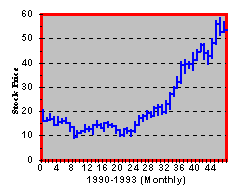![]() 1.1 OVERVIEW
1.1 OVERVIEW
When you want to invest money you go to the capital market. When a corporation wants to raise money, it also goes to the capital market. The capital market is where suppliers of capital (typically savers or investors) meet the demanders of capital (typically corporations and governments).
In the capital market, the suppliers and demanders of capital trade a variety of financial assets, such as stocks, bonds, options, currencies, futures contracts, and so on. The theory of investments studies how investment decisions are made and how the values of financial assets are determined.
To make things concrete, lets look at the Chrysler Corporation. Investors hold billions of dollars in Chrysler stock (the value of Chrysler stock on December 31, 1993, was $53.50 per share). In 1993, Chrysler issued new shares and raised $1.95 billion in new capital. In addition Chrysler's president predicted in 1993 that demands for capital over the next five years would total $17.5 billion. Chrysler's management uses this money to design, manufacture, and market cars and trucks.
Chrysler's stock is traded on the New York Stock Exchange. In Figure 1.1, we show you its price history over a significant period of time in Chrysler's history.
Figure 1.1
Chrysler Stock Price Graph

You can see that the performance of Chrysler stock improved dramatically between 1990 and 1993. In fact, Chrysler has moved from the brink of bankruptcy to become one of the world's most profitable automotive companies. This turnaround has relied on raising billions of dollars from capital markets to finance its projects.
Why would you buy shares in a firm? A share is a financial asset that gives you a (residual) claim on the assets of a firm. If a firm is expected to do well, ownership can provide large gains in the form of increased prices for each share. This expected return provides the motivation for buying the shares. In terms of investment theory, it is assumed that investors prefer more return to less return.
To understand the return from buying a stock, let us take a closer look at Chrysler's stock price graph in Figure 1.1. The graph plots the monthly high-low price range, with the tick mark to the right of each price range representing the closing price for the month.
The return from buying and holding Chrysler stock depends upon the price at the time of purchase, the holding period, the total dividend payments received, and the price at the end of the holding period.
Suppose your first stock market investment is to purchase Chrysler stock at the closing January 1990 price of $16. Suppose you hold Chrysler for one year collecting $1.20 in dividends, and then sell for $12 5/8. Ignoring the effects of the different times that dividends are paid over this period, your realized return from this investment is:
Realized Return = (12 5/8 + 1.20 - 16)/16 = -13.6%
If this is your first investment, you might consider never investing in the stock market again!
Suppose instead of staying out of the market, you once again purchase Chrysler at the closing October 1992 price of $27 1/8. Although initially this may be a bitter pill to swallow (with the memories of selling at $12 5/8 still fresh), you would feel much better twelve months later when Chrysler is selling at $55 7/8. Over this time you would also receive $.60 in dividends per share. Again, ignoring the different times that dividends are paid over this period, your return from Chrysler is
Realized Return = (55 7/8 + .60 - 27 1/8)/27 1/8 = +108.2%
These real Chrysler numbers make it very clear that at any particular time, individual stock returns can be very volatile. In fact, the performance of a company depends on many factors beyond its control. These include the strength of the economy, global competition, technological change, and financial risk such as changes in exchange rates or interest rates. These and other factors make stock prices, and hence returns, inherently volatile. This volatility makes buying a stock risky. The return at one time may be higher than expected, but on the down side, it could also be lower and even negative. This means that an investor cannot expect to earn large returns in the stock market without assuming some risk. The essence of the problem is how to manage both the risk and the return of your investments. In the language of investment theory, it is assumed that investors prefer less risk to more.
Of course, while Chrysler's past performance is of interest, what concerns you most is the forecast of its future returns and the risk associated with this forecast. Historical returns are useful only insofar as they provide information about future returns. Indeed investment prospectuses state that, "past results are no guarantee of future performance."
You, and other investors, face the problems of
1. Forecasting future returns.
2. Identifying sources of risk and measuring risk.
3. Evaluating whether the expected return compensates for the risk.
4. Making investment decisions.
How the market as a whole resolves these problems determines the value (price) of every stock. The price is the value today of the future returns given the risk associated with the returns.
The remainder of this chapter lets you read about various components of the investment problem, starting with a summary of the valuation problem.
previous topic
next topic
(C) Copyright 1999, OS Financial Trading System